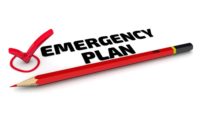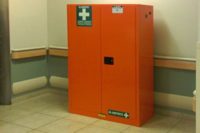 Earthquakes, mud slides and flooding of monumental proportion; it's not uncommon to hear about disasters such as these occurring around the world. Emergency Preparedness Week is May 6-12, 2012. So, this is a perfect time to ask yourself if an emergency were to occur at work or at home, would you know what to do? Would you be prepared?
Earthquakes, mud slides and flooding of monumental proportion; it's not uncommon to hear about disasters such as these occurring around the world. Emergency Preparedness Week is May 6-12, 2012. So, this is a perfect time to ask yourself if an emergency were to occur at work or at home, would you know what to do? Would you be prepared?
No one knows exactly when or where an emergency will occur; they can happen fast, with little warning. What we do know is that planning and preparing ahead can help you and your organization cope better during and after a major disaster, prevent fatalities, injuries, and property damage, and minimize the impact on families, workplaces, and the community.
Prepare at home
There are three main steps that families should take to prepare for any emergency that may arise:
1. Know the risks in your community. Understand what natural and technological disasters are most likely to happen in your community to help you understand what to prepare for.
2. Make a family emergency plan. Once you know the types of disasters that are most likely to happen, make a plan to evacuate your home and/or community (if needed) and keep your family fed, warm and safe for 72 hours or until help can reach you. Determine what special accommodations you must make for anyone with disabilities and/or special needs, as well as your pets.
3. Get or make an emergency preparedness kit with enough food, water and other supplies to meet your family's needs for at least 72 hours. Store the supplies in sturdy, easy-to-carry containers such as suitcases on wheels or backpacks in case you need to evacuate your home.
The Red Cross and the GetPrepared.ca websites have advice and detailed instructions on each step, the links to which are provided at the end of this article.
Prepare at work
Preplanning by workplaces is essential to being able to handle unexpected situations effectively and protect employees, reduce damage to buildings and equipment, and help get operations up and running normally as soon as possible. During an emergency, decisions have to be made quickly. To avoid chaos, it's important to know in advance who to call, what to do, and who will be in charge.
Employers have a responsibility to develop an emergency plan, share it with their employees, test and review it regularly, and revise it as necessary to reflect any changes that have occurred in plant infrastructure, processes, materials used, and key personnel.
The emergency plan includes:
• all possible emergencies, consequences, required actions, written procedures, and the resources available,
• detailed lists of personnel including their home telephone numbers, their duties and responsibilities,
• floor plans, and
• large scale maps showing evacuation routes and service conduits (such as gas and water lines).
There are steps you can take to develop a plan for your workplace:
1. Conduct a vulnerability assessment to determine which technological (chemical or physical) and natural hazards pose a threat; the possible major impacts of each (i.e. work disruption, casualties, damage to equipment); how likely a situation is to occur; and what is necessary to prevent it from happening.
2. Involve others in the planning process - such as the joint occupational health and safety committee - to get valuable input.
3. Establish appropriate emergency procedures based on the vulnerability analysis.
4. Clearly define specific duties, responsibilities, and the chain of command for
reporting the emergency, activating the emergency plan, alerting and evacuating staff, handling casualties, containing the situation, and communicating with the external agencies, media, and others as required.
5. Identify evacuation routes and alternate means of escape and inform and rehearse them with staff.
6. Specify safe locations for staff to gather for head counts to ensure that everyone has left the danger zone. Assign individuals to assist employees who have special needs.
In the words of Benjamin Franklin, "by failing to prepare you are preparing to fail." Let Emergency Preparedness Week serve as a friendly reminder to plan ahead and be prepared - for anything.
Source: Canadian Centre for Occupational Health and Safety, The Health and Safety Report



